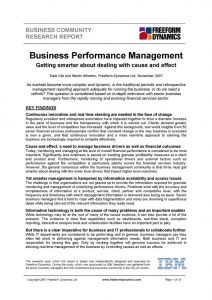Business performance management 14 years on: still chasing the real-time dream
As our contribution to the bit of fun that is Throwback Thursday, we’re taking a regular stroll in the Freeform Dynamics archives.
“Continuous innovation and real-time steering are needed in the face of change” is a message which is difficult to argue with. That’s especially true against the backdrop of pandemic-induced disruption of markets, workforces, customer interactions and so many other aspects of business.
Yet the above statement was the lead finding from a research study we conducted in 2007 into the then current state of business performance management. The backdrop at that time – the year the first iPhone was launched – was how the shape and pace of the economic landscape were changing, thanks to the combination of pervasive and continuous connectivity with widespread automation.
With this i n mind, our research respondents highlighted the inadequacy of the data and insights available to those involved in business management and decision-making. Too often, information was backward-looking, out of date, and inconsistent or incomplete. There was also a heavy focus on monitoring business outcomes – overall revenue and profit, for example – with much less attention paid to ‘lead indicators’ such as customer-related metrics, operational performance and so on.
n mind, our research respondents highlighted the inadequacy of the data and insights available to those involved in business management and decision-making. Too often, information was backward-looking, out of date, and inconsistent or incomplete. There was also a heavy focus on monitoring business outcomes – overall revenue and profit, for example – with much less attention paid to ‘lead indicators’ such as customer-related metrics, operational performance and so on.
The report concluded that it was necessary to create a culture of real-time business management. We noted that business executives and managers must better embrace the concept of ‘cause and effect’, to allow effective real-time steering of the business, and we saw technology advances in areas such as information management and analytics as important enablers here.
Wind the clock forward to today’s digital business environment, and all of this is now sorted, right?
Continuous real-time insight is still in short supply
Wrong. Fewer than 5% of the organisations assessed against a data maturity model in a more recent study could be objectively considered as ‘data-driven’. To qualify for this status, it was necessary to demonstrate that continuous real-time insights were being delivered proactively and in context across the business, which few were able to do. Most were at stages 2 and 3 in our 4-stage maturity model – ‘data-sustained’ and ‘data-empowered’ respectively.
To be fair, the capabilities reported in late 2020 were certainly better than those in 2007 overall. The problem is that the challenges have escalated considerably in the intervening period.
The amount of data now generated through digital marketing, process automation and IoT is huge compared to 14 years ago. Furthermore, that data is even more fragmented nowadays, typically spreading across multiple cloud-based environments as well as on-prem systems.
Even AI can’t solve the cultural challenges
Again, at least part of the answer lies in technology advancement, this time with a focus on AI and machine learning. But changing business models and processes to take advantage of modern solutions takes time, as does transforming mindsets and culture. Sadly, as ever, there are no magic bullets, which is why progress is never as fast as analysts and pundits predict.
That said, it’s encouraging that many have an eye on the real-time business management prize when it comes to prioritising and scoping modernisation and digital transformation initiatives. In another recent study, for example, SAP customers cited the ability to generate insights in real-time from operational data gathered from multiple sources as a major driver for migration to S/4HANA.
Zooming out from all of this, it’s clear that the fundamental objective of business performance management hasn’t changed since 2007. And while it’s anyone’s guess what the specific challenges will be in 14 years’ time, one thing for certain is that an ability to rapidly ‘sense-and-respond’ will be more critical than ever from a business management perspective in 2035!



